 Sunday/Weekend
Sunday/Weekend

Lương Nghĩa Dũng, a veteran war photojournalist from the Vietnam News Agency (VNA) who fell just a few hours before the end of the battle for Quảng Trị on May 1, 1972, is among this year’s nominees for Hồ Chí Minh Award, the country’s highest honour.
60023101PM.jpg) |
| Brave: War photojournalist Lương Nghĩa Dũng on Highway 9 Front. — Photo courtesy of Lương Nghĩa Dũng’s family |
by Phạm Hoàng Anh
HÀ NỘI — The American War in Việt Nam ended some forty years ago. For most Vietnamese people the war is a thing of the past, even for those who went through it. They do not want to talk about the war, the suffering and sacrifices they have made. However, most of them cannot help but recall those moments while looking at war photos.
Those powerful images, taken by war photojournalists amidst gun smoke and carnage on the battlefields — oftentimes paid for with the price of their own blood — hold the power to bring tears to the eyes of even the most seasoned warriors.
Lương Nghĩa Dũng, born in Hà Đông town on the outskirts of Hà Nội, a veteran war photojournalist from the Vietnam News Agency (VNA) who fell just a few hours before the end of the battle for Quảng Trị on May 1, 1972, is among this year’s nominees for Hồ Chí Minh Award, the country’s highest honour in the fields of literature and arts.
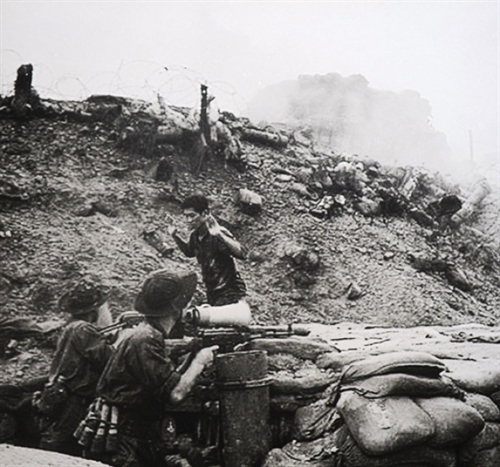 |
| Victory and defeat: Saigon-regime soldiers surrender at Height 365 in Quảng Trị Province. |
When American bombers carried out their campaign to bring North Việt Nam "back to the Stone Age" in 1965, Dũng was a 31-year-old physics teacher and did not know much about how to use a camera. He took a short training course on photojournalism at the VNA with two other young teachers, Vũ Tạo and Hứa Kiểm. The three later formed the most prolific war photojournalist group of the American War.
“He was a true war photojournalist,” said Hứa Kiểm, his longtime friend and colleague. “As war photojournalists, we all had to face death from time to time, but he was never afraid to throw himself in the midst of battle.”
Cheating death
Kiểm recalled at least three times he and Dũng escaped death within just 12 months while the duo was on a mission to cover some of the fiercest battles during the American war of destruction against North Việt Nam.
In 1967, Dũng and Kiểm were tasked with covering an artillery battle in Vĩnh Linh, Quảng Bình Province. They were asked to be on stand-by near the frontline by the battery commander because it would be very dangerous to move around once the duel commenced with artillery pieces from both sides firing at each other’s positions.
“We just started our lunch at the battery’s dining shelter, which was just a thatch-roofed trench 1.7m deep, 4m wide and 6m long, when the alarm sounded. There were two of us and the cook,” recalled Kiểm. “Dũng and I grabbed our cameras and rushed to the battle. That was when I felt an immense pressure from behind pinning me to the ground.
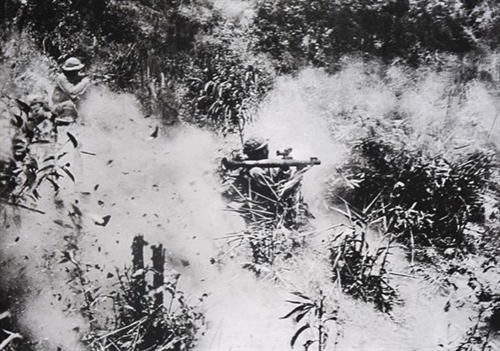 |
| Reality of war: Vietnamese People’s Army soldiers exchange fire with enemies on Highway 9 Front. |
“We were on the ground for a while as soil, rock and broken tree branches were falling over us. When we looked back, the shelter was gone. There was just a large crater instead. We couldn’t have gone more than 40m from it. The cook was killed immediately.”
Another close call was on National Route 1 when they were cycling back to Hà Nội after the assignment. The two photojournalists were starving for protein after months of a diet consisting only of dried food and vegetables. When they arrived at Quán Hành Train Station in Nghi Lộc, Nghệ An Province, they spotted a lot of crows sitting idly on tree branches looking down at fish ponds that belonged to local villages.
"We were given two K54 pistols for our protection, but we never used them for anything. I told Dũng that this was as good a time as any to fire our first shots," Kiểm laughed.
As they took aim at the birds, Kiểm saw a black object getting bigger and bigger in the sky. He only had time to yell to Dũng, "Lie down".
"I lost all sense of direction. The only thing I saw was a huge pile of bamboo trees. I thought to myself that had he been buried under those trees, it would take a platoon of local militias to retrieve his body," Kiểm said.
Dũng was fine. A bomb fell so close to the duo’s position that it uprooted the trees and tossed them right between the two. To their surprise, the road was covered with fish, and the birds were all over them. That day the two hungry war photojournalists treated themselves to a bountiful meal of fish.
The train station was located right next to National Route 1, making it a perfect target for American bombers. Destroying the station and the road would effectively brake the North’s transportation network. Bombers who failed to strike other targets were ordered to dump everything on this bridge before returning to base.
"That’s why the crows sit there in waiting. They knew after the bombs, there was going to be a lot of fish. We only figured it out later," Kiểm said.
“That was close, but perhaps the narrowest escape from death for Dũng was at Phú Lương Bridge, Hải Dương Province,” Kiểm said. “We all thought he died. Even the anti-air aircraft’s recon officer confirmed his death.”
Phú Lương Bridge was one of the key targets of American bombers during their bombing campaign in North Việt Nam.
“Dũng was standing on top of a chicken coop built with discarded ammo cases,” Kiểm said. “It was sticking out like a sore thumb, but he chose that position because it offered a view of both the bridge and the anti-aircraft artillery unit charged with protecting it.
“A rocket hit the chicken coop. It was a direct hit. The unit’s recon officer saw Dũng being blown away. He was sure nobody would survive that. That’s why he radioed in that the photojournalist was killed in action.”
Miraculously Dũng survived without a scratch. When Kiểm and his supervisor came back to the battleground to retrieve Dũng’s body, they found him in a borrowed uniform eating rice with the soldiers.
“We couldn’t believe our eyes. Dũng joked that he felt fine but a little bit hungry because the explosion sent him up too high in the air,” Kiểm said. “We were all overwhelmed with joy that day.”
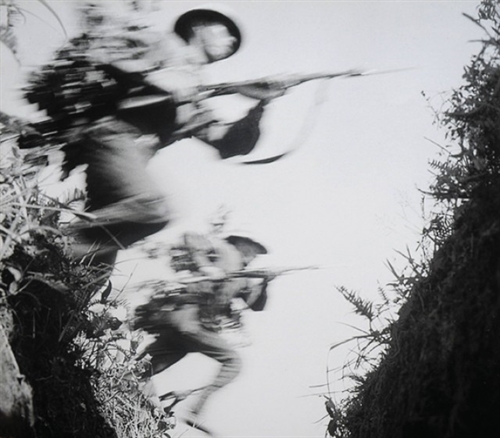 |
| Charge!: People’s Army of Việt Nam soldiers jump over a trench during an attack with their bayonets ready for melee combat. |
From one battle to another
Dũng travelled tens of thousands of kilometres within a span of six years during his career as a war photojournalist. He was at some of the most heavily bombed sites in North Việt Nam, the infamously brutal 17th parallel that separated the country and even the foreign frontier of Savanakhet in Laos. His legacy consists of thousands of photos taken of battles, soldiers and ordinary people who rose up to fight and gave their lives for their country.
During these long years, it became a running joke at the VNA headquarters that any reports of Dũng’s death should be discarded because he just simply wouldn’t yield to death.
But even Dũng couldn’t cheat death forever. A few hours before the liberation of Quảng Trị in 1972, he was killed while following a unit mounting a charge on the town.
“He died the same way he lived and worked through his whole life,” Kiểm said. “I know Dũng well. He wanted to be on the frontline, and it carries certain risks. He always knew that.”
Kiểm saw his fair share of war and battles. After the death of his close friend and colleague, Kiểm went on to join the soldiers who marched into Sài Gòn, now Hồ Chí Minh City, on that unforgettable day of April 30, 1975, and later joined war efforts against the genocidal Khmer Rouge regime in Cambodia. But even he had to admit that going to the frontline as often as his friend did was no easy decision.
“Until this day I still don’t know how he did it,” Kiểm said. “It is one thing to be constantly on the front line when you are young and without a family. It felt much heavier when you have children that you have to leave behind. Dũng had four little ones and he never refused an assignment knowing that it could very well be the last time he would see them.”
For Dũng, Kiểm and others of their generation, the country’s freedom and independence were worth risking their lives and so much more for, much like a song Dũng was often heard humming by his friends: “We will keep going to wherever the enemies are.” — VNS
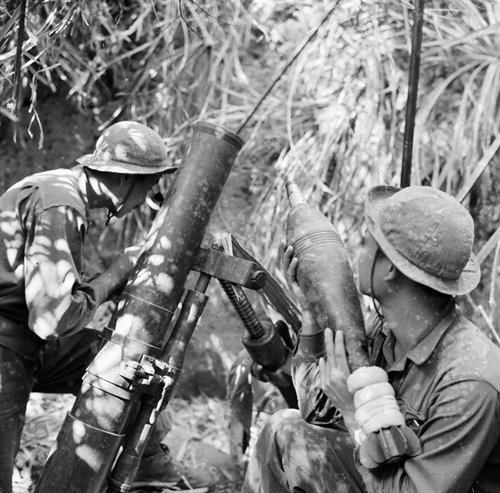 |
| Act fast: An artillery battery during an attack on Highway 9 Front. |
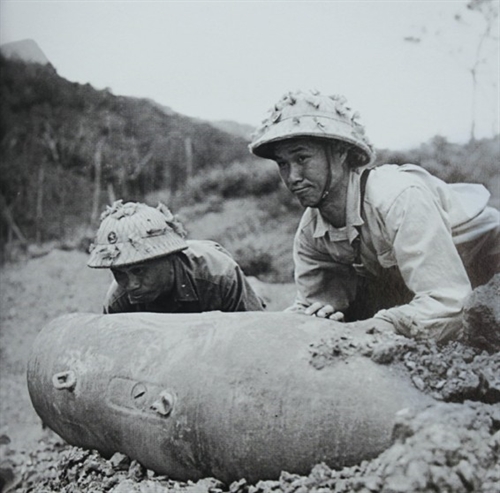 |
| Risky business: Soldiers from Sapper Company 6 push a delayed bomb into a nearby stream to clear the road. |
 |
| Snapshot of battle: Return fire by the Women’s Ngư Thủy Artillery Company, Quảng Bình Province. The company was established in 1967 and included 37 young women aged 16 to 22. During their service (1968-1972), the company, equipped with three 85mm artillery pieces, was reported to have sunk a total of five American warships. — Photos Lương Nghĩa Dũng/VNA. |
 |
| Haunting image: Artillery battery 13 during a battle at Dốc Miếu Base in 1968. — Photos Lương Nghĩa Dũng/VNA |




